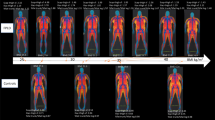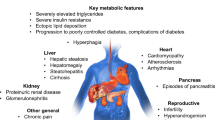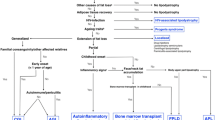Abstract
Familial partial lipodystrophy are Mendelian disorders involving abnormal body fat distribution and insulin resistance. The current classification includes the Köbberling syndrome (type 1 familial partial lipodystrophy), characterized by fat loss in the lower limbs and abnormal fat accumulation in other areas. Type 1 familial partial lipodystrophy appears to be heritable, but little is known about it, including putative contributing mutations. We aimed to characterize this syndrome better by evaluating a group of women with phenotypic features of type 1 familial partial lipodystrophy. This is a case-controlled study in which 98 women with type 1 familial partial lipodystrophy that lacked classical mutations known to cause familial partial lipodystrophy were compared with 60 women without lipodystrophy and 25 patients with type 2 familial partial lipodystrophy (Dunnigan disease). Clinical course, body composition by dual-energy X-ray absorptiometry, HbA1c, lipid profile, insulin, leptin and family history were evaluated in all of the participants. Analyses of receiver-operating characteristic curve were performed for type 1 familial partial lipodystrophy diagnosis, comparing different truncal/limbs ratios. Among patients with type 1 familial partial lipodystrophy, 68 % developed recognizable lipodystrophy before adolescence, and most displayed an autosomal-dominant pattern (86 %). Women with type 1 familial partial lipodystrophy had less lower-limb adipose tissue than women without lipodystrophy, but significantly more than patients with Dunnigan disease. Moreover, metabolic disturbances occurred more frequently in the type 1 familial partial lipodystrophy group (81 %) than in the non-lipodystrophic group (30 %, p<0.05). The severity of metabolic disturbances was inversely proportional to the percentage of fat in the lower extremities and directly proportional to the amount of visceral adipose tissue. Metabolic profiles were worse in type 1 familial partial lipodystrophy than in Dunnigan disease. According to the receiver-operating characteristic curve analysis, the best ratio was subscapular/calf skinfolds (KöB index), with a cut-off value of 3.477 (sensitivity: 89 %; specificity: 84 %). Type 1 familial partial lipodystrophy was an early-onset, autosomal-dominant lipodystrophy, characterized by fat loss in the lower limbs and abnormal fat accumulation in the abdominal visceral region, associated to insulin resistance and metabolic disorders. A KöB index >3.477 is highly suggestive of this syndrome.



Similar content being viewed by others
References
H. Cao, R.A. Hegele, Nuclear lamin A/C R482Q mutation in Canadian kindreds with Dunnigan-type familial partial lipodystrophy. Hum. Mol. Genet. 9, 109–112 (2000)
I. Barroso, M. Gurnell, V.E. Crowley, M. Agostini, J.W. Schwabe, M.A. Soos et al., Dominant negative mutations in human PPARgamma associated with severe insulin resistance, diabetes mellitus and hypertension. Nature 402, 880–883 (1999)
A.K. Agarwal, A. Garg, A novel heterozygous mutation in peroxisome proliferator-activated receptor-gamma gene in a patient with familial partial lipodystrophy. J. Clin. Endocrinol. Metab. 87, 408–411 (2002)
K. Tan, W.A. Kimber, J. Luan, M.A. Soos, R.K. Semple, N.J. Wareham, S. O’Rahilly, I. Barroso, Analysis of genetic variation in Akt2/PKB-beta in severe insulin resistance, lipodystrophy, type 2 diabetes, and related metabolic phenotypes. Diabetes 56, 714–719 (2007)
O. Rubio-Cabezas, V. Puri, I. Murano, V. Saudek, R.K. Semple, S. Dash et al., Partial lipodystrophy and insulin resistant diabetes in a patient with a homozygous nonsense mutation in CIDEC. Embo. Mol. Med. 1, 280–287 (2009)
S. Gandotra, C. Le Dour, W. Bottomley, P. Cervera, P. Giral, Y. Reznik et al., Perilipin deficiency and autosomal dominant partial lipodystrophy. N. Engl. J. Med. 364, 740–748 (2011)
S.M. Farhan, J.F. Robinson, A.D. McIntyre, M.G. Marrosu, A.F. Ticca, S. Loddo et al., A novel LIPE nonsense mutation found using exome sequencing in siblings with late-onset familial partial lipodystrophy. Can. J. Cardiol. 30, 1649–1654 (2014)
K.L. Herbst, L.R. Tannock, S.S. Deeb, J.Q. Purnell, J.D. Brunzell, A. Chait, Kobberling type of familial partial lipodystrophy: an underrecognized syndrome. Diabetes Care 26, 1819–1824 (2003)
A. Garg, R.M. Peshock, J.L. Fleckenstein, Adipose tissue distribution pattern in patients with familial partial lipodystrophy (Dunnigan variety). J. Clin. Endocrinol. Metab. 84, 170–174 (1999)
T.P. Nedungadi, D.J. Clegg, Sexual dimorphism in body fat distribution and risk for cardiovascular diseases. J. Cardiovasc. Transl. Res. 2, 321–327 (2009)
B. Donadille, O. Lascols, J. Capeau, C. Vigouroux, Etiological investigations in apparent type 2 diabetes: when to search for lamin A/C mutations? Diabetes & Metabolism 31, 527–532 (2005)
D. Araujo-Vilar, L. Loidi, F. Dominguez, J. Cabezas-Cerrato, Phenotypic gender differences in subjects with familial partial lipodystrophy (Dunnigan variety) due to a nuclear lamin A/C R482W mutation. Horm. Metab. Res. 35, 29–35 (2003)
R.A. Hegele, C.M. Anderson, J. Wang, D.C. Jones, H. Cao, Association between nuclear lamin A/C R482Q mutation and partial lipodystrophy with hyperinsulinemia, dyslipidemia, hypertension, and diabetes. Genome Res. 10, 652–658 (2000)
A. Garg, Gender differences in the prevalence of metabolic complications in familial partial lipodystrophy (Dunnigan variety). J. Clin. Endocrinol. Metab. 85, 1776–1782 (2000)
G. Bidault, M. Garcia, M.C. Vantyghem, P.H. Ducluzeau, R. Morichon, K. Thiyagarajah et al., Lipodystrophy-linked LMNA p.R482W mutation induces clinical early atherosclerosis and in vitro endothelial dysfunction. Arterioscler. Thromb. Vasc. Biol. 33, 2162–2171 (2013)
M.C. Vantyghem, D. Vincent-Desplanques, F. Defrance-Faivre, J. Capeau, C. Fermon, A.S. Valat et al., Fertility and obstetrical complications in women with LMNA-related familial partial lipodystrophy. J. Clin. Endocrinol. Metab. 93, 2223–2229 (2008)
H.F. Escobar-Morreale, J.L. San Millan, Abdominal adiposity and the polycystic ovary syndrome. Trends. Endocrinol. Metab. 18, 266–272 (2007)
M.G. Dunnigan, M.A. Cochrane, A. Kelly, J.W. Scott, Familial lipoatrophic diabetes with dominant transmission. A new syndrome. Q. J. Med. 43, 33–48 (1974)
J. Kobberling, B. Willms, R. Kattermann, W. Creutzfeldt, Lipodystrophy of the extremities. A dominantly inherited syndrome associated with lipatrophic diabetes. Humangenetik 29, 111–120 (1975)
J. Kobberling, M.G. Dunnigan, Familial partial lipodystrophy: two types of an X linked dominant syndrome, lethal in the hemizygous state. J. Med. Genet. 23, 120–127 (1986)
S.N. Jackson, T.A. Howlett, P.G. McNally, S. O’Rahilly, R.C. Trembath, Dunnigan-Kobberling syndrome: an autosomal dominant form of partial lipodystrophy. Q. J. Med. 90, 27–36 (1997)
M.S. Treuth, G.R. Hunter, T. Kekes-Szabo, Estimating intraabdominal adipose tissue in women by dual-energy X-ray absorptiometry. Am. J. Clin. Nutr. 62, 527–32 (1995)
J. Sambrook, E.F. Fritsch, T. Maniatis, Molecular cloning: a laboratory manual. 2nd ed. Cold Spring Harbor Laboratory, Cold Spring Harbor, NY (1990)
J.C. Levy, D.R. Matthews, M.P. Hermans, Correct homeostasis model assessment (HOMA) evaluation uses the computer program. Diabetes Care 21, 2191–2192 (1998)
D.W. Hosmer, S. Lemeshow, E. Cook, Applied Logistic Regression. 2nd ed. John Wiley & Sons, New York, NY (2000)
A.D. Bohr, K. Laurson, M.B. McQueen, A novel cutoff for the waist-to-height ratio predicting metabolic syndrome in young American adults. BMC Public Health 16, 295 (2016)
M.B. Snijder, J.M. Dekker, M. Visser, L.M. Bouter, C.D. Stehouwer, P.J. Kostense et al., Associations of hip and thigh circumferences independent of waist circumference with the incidence of type 2 diabetes: the Hoorn Study. Am. J. Clin. Nutr. 77, 1192–1197 (2003)
S. Yusuf, S. Hawken, S. Ounpuu, L. Bautista, M.G. Franzosi, P. Commerford et al., Obesity and the risk of myocardial infarction in 27,000 participants from 52 countries: a case-control study. Lancet 366, 1640–1649 (2005)
Acknowledgments
We are indebted to the patients of this study for their collaboration. This study has been funded by the Instituto de Salud Carlos III (grant number: PI081449) and the European Regional Development Fund, FEDER. In addition, SRG was awarded a Research Fellowship, granted by the Asociación Española de Familiares y Afectados de Lipodistrofias (AELIP).
Author information
Authors and Affiliations
Corresponding author
Ethics declarations
Conflict of interest
The authors declare that they have no competing interests.
Electronic supplementary material
Rights and permissions
About this article
Cite this article
Guillín-Amarelle, C., Sánchez-Iglesias, S., Castro-Pais, A. et al. Type 1 familial partial lipodystrophy: understanding the Köbberling syndrome. Endocrine 54, 411–421 (2016). https://doi.org/10.1007/s12020-016-1002-x
Received:
Accepted:
Published:
Issue Date:
DOI: https://doi.org/10.1007/s12020-016-1002-x




